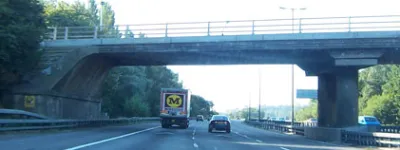Some of the earliest proposals of this type of junction are found in the wartime reconstruction bible, the County of London Plan 1943, which sets out standard types of road junction to be adopted on the world-class highway network that we never ended up building. Amongst its words of advice are an awful lot of sharp-cornered rotaries, and in its detailed area plans, every one of London's headache inducing multiple-road junctions is equipped with a spiky and unique angular roundabout.
Perfection through deflection
In a way, we're back to square one with roundabout design. Fashions have come and gone for squares and angles, small islands and no islands, enormous sweeping racetracks, and peculiar gyratories hammered together from existing streets and squares. Not any longer. No, today we're back at a nice moderately-sized roundabout that is perfectly circular. Plus ça change and all that.
There's more to it than that, of course. Design practice now does prefer a circular roundabout unless there's a good reason to use something else, making journeys through the junction flow smoothly through left, right, left again. But the key now is not shape but deflection.
Deflection is the angle at which you enter and exit the roundabout. Ideally you should approach it head-on and then curve left at the last moment, forcing you to slow down and discouraging you from ploughing straight on to the junction. The exit, on the other hand, should be smoother, curving left out of the roundabout and straightening up to match acceleration away from the junction.
It's not easy to get right, and it's noticeable when it's missing. Some early roundabouts, for example, will force you on and off the junction at the same angle, which makes either the entry too fast or the exit too tight. Across much of the New Town of Stevenage, the roundabouts appear to have been designed for conversion to right-hand driving, because the deflection appears to be all the wrong way around.
Because of the nature of this type of junction, every roundabout is unique: it depends on the type of roads that it connects, the angle at which they approach, the space available, the flows of traffic expected, the pedestrian provision necessary and a hundred other fiddly factors. That means it depends heavily on the skill of the designer. Today we've got the roundabout more or less sorted: not too fast, not too slow, not too smooth, not too uncomfortable, and if you get one competently designed, it should be rather nice to drive around.
Maybe that's why we get a bit obsessive about them...
Picture credits
- Plan showing pentagonal and hexagonal roundabouts extracted from the County of London Plan (1943), now out of copyright.
